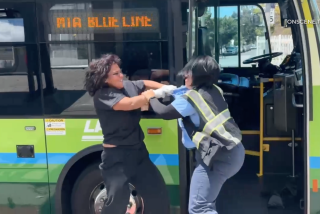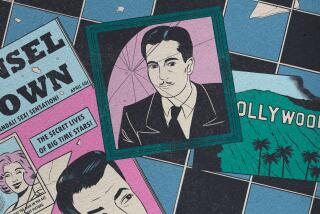Opinion: Two months after Orlando, a new threat hovers over the LGBT community: Security theater
- Share via
It has been two months since a lone gunman opened fire on Orlando’s Pulse nightclub, killing 49 and injuring 53 others in the deadliest mass shooting in U.S. history. Since that time, gay bars in New York, Cleveland, Chicago, Sacramento, Miami, New Orleans, and Phoenix have all expanded their security measures in response to the shooting. If you’re LGBT in America, going out for a night out on the town has increasingly starting to resemble a trip to the airport—complete with pat downs, handheld wands, and full-on metal detectors.
“It’s the new normal,” Cip Cipriano, manager of San Francisco’s QBar, told the San Francisco Chronicle after his city’s historic Castro district beefed up security for its 2016 Pride event, screening visitors with a metal detector for the first time ever.
Black Lives Matter, the national activist group scheduled to grand marshal the San Francisco Pride event, pulled out due to concerns about increased police presence and the historically fraught relationship between law enforcement and racial minorities. “As queer people of color, we are disproportionately targeted by both vigilante and police violence,” the group said in a statement. “We know firsthand that increasing the police presence at Pride does not increase safety for all people.”
Queer people of color aren’t the only group that should be concerned about increased militarization. While it might make us feel better in the short term, there’s little evidence that bringing TSA-style security to your local gay bar will do anything to stop future violence. You might have to wait longer to get a drink, but deepening America’s toxic relationship with surveillance isn’t the solution our community needs.
Following the September 11 attacks, the Bush administration created the Transportation Security Authority, better know as the TSA. The $9-billion-a-year entity was designed to make it safe to travel again amidst a climate of fear and anxiety about when terrorists might strike next.
It has not done so. Despite employing 50,000 staffers, a 2015 report showed that it remains shockingly easy for those carrying deadly weapons to pass through TSA undetected. In 67 out of 70 cases, members of the governmental organization’s Red Team, who disguise themselves in order to test the efficiency of safety protocol, got through security without being flagged. The fact that TSA fails to stop potential terrorists 95 percent of the time shouldn’t be a surprise:In the first decade after its creation the organization still hadn’t thwarted a single major attack.
If you’re LGBT in America, going out for a night out on the town has started to resemble a trip to the airport—complete with pat downs and metal detectors.
Security technologist Bruce Schneier, who has been highly critical of the TSA, calls the TSA “security theater,” meaning it only gives the illusion of safety. He believes that there’s a reason that the measures instituted in the past fifteen years—including taking off one’s shoes at security checkpoints and passing through body-scanners—have been so ineffective.
“Focusing on specific threats like shoe bombs or snow-globe bombs simply induces the bad guys to do something else,” he told Vanity Fair in 2011. “You end up spending a lot on the screening and you haven’t reduced the total threat.”
What these policies have actually done is put the burden of security on certain groups, who are disproportionately surveilled and harassed by TSA workers. Although TSA has a policy against racial and ethnic profiling, its workers are nonetheless encouraged to submit passengers from “countries associated with significant terrorist activity” to additional screening. Those guidelines have led to Muslims being frequently subjected “random searches.”
Transgender people have also felt the weight of TSA protocol. In 2015, Shadi Petosky, a trans woman attempting to board a flight in Orlando, Fla., was detained for 40 minutes after a body scanner detected an “anomaly” in her groin. Petosky explained the situation but was harassed and humiliated by airport employees, who caused her to miss the flight. Despite backlash from the trans community, the TSA stood by its policy.
If added security hasn’t made airports safer, the same has been true for schools. After the Columbine shooting in 1999, high schools across the country rolled out metal detectors. But when a shooter armed with an AR-15 murdered 20 first-graders and six adults in Newtown, Conn., he didn’t go through the school’s security—as guests of the Sandy Hook Elementary School have to sign in at the front desk. He shot out the window adjacent to the lobby door instead.
Since Sandy Hook, our schools have never been more heavily surveilled, outfitted with security cameras and armed guards. Currently, students in more than 236 schools in New York alone have to pass through metal detectors every single day, a majority of whom are youth of color. Some students have to wait nearly three hours just to get in the building.
But despite that heavy emphasis on security, the rate of school shootings hasn’t slowed: Since Dec. 2012, there have been an additional 186 attacks on campuses across the U.S. That averages out to one shooting every week.
Everyone has the right to feel secure and protected, and there are things that gay bars can do to make our spaces feel safe again, including checking patrons’ bags and teaching staff how to swiftly respond to emergencies. But replicating the same mistakes as the TSA and public school administrators may have the opposite effect as what is intended—especially considering that 80 percent of gay black men claimed in a 2015 survey that they had experienced racism in LGBT spaces. Any solution that puts people of color at additional risk for profiling isn’t the answer.
When I visited a gay bar in Philadelphia following the Orlando shooting, I was wanded and submitted to a thorough pat down, while a security guard asked me to clear my pockets. When he felt my wallet, he asked what was inside it. “My money?” I responded, confused about what was happening. I opened it to illustrate that I didn’t pose a threat to the bar.
I left upset and angry. For the first time since the tragedy at Pulse, I was scared for the future of my community.
Nico Lang is the East Coast reporter for the Advocate. You can also read his work on Salon, Onion A.V. Club and the Guardian. Find him on Twitter @nico_lang.
Follow the Opinion section on Twitter @latimesopinion and Facebook
More to Read
A cure for the common opinion
Get thought-provoking perspectives with our weekly newsletter.
You may occasionally receive promotional content from the Los Angeles Times.









